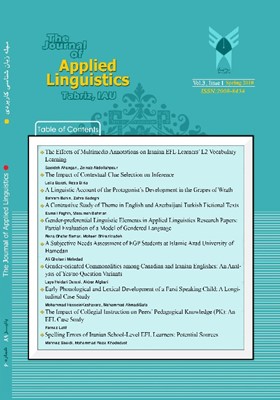Gender-preferential Linguistic Elements in Applied Linguistics Research Papers: Partial Evaluation of a Model of Gendered Language
الموضوعات :رضا غفارثمر 1 , محسن شیرازی زاده 2
1 - Tarbiat Modares University
2 - Tarbiat Modares University
الکلمات المفتاحية: genre, gendered language, second language, Applied Linguistics,
ملخص المقالة :
This article intended to investigate whether the gender-preferential linguistic elements found by Argomon, Koppel, Fine and Shimoni (2003) show the same gender-linked frequencies in applied linguistics research papers written by non-native speakers of English. In so doing, a sample of 32 articles from different journals was collected and the proportion of the targeted features to the whole number of words was calculated. The results indicated that, although the gender-linked patterns of use for many of those features were also observed in our sample, the difference between men and women in the frequency of using those elements was not statistically significant. This non-significant difference shows that either the confinements of genre or those of using a second language or both are keeping L2 writers from expressing their gender to its fullest capacity in the texts they produce.
Argamon, S., Koppel, M., Fine, J., & Shimoni, A. (2003). Gender, genre, and writing style in formal written texts. Text, 23, 321–346.
Baron, N. S. (1998). Letters by phone or speech by other means: the linguistics of email. Language and Communication, 18, 133-170.
Coates, J. (1998). Language and gender: A reader . Oxford: Blackwell.
Colley, A., & Todd, Z. (2002). Gender-linked differences in the style and content of emails to friends. Journal of Language and Social Psychology, 21, 380-392.
Crawford, M. (1995). Talking difference. London: Sage.
Eckert, P. (1997). Gender and sociolinguistic variation. In J. Coates (Ed.), Readings in Language and Gender (pp. 64–75). Oxford: Blackwell.
Herring, S. C., & Paolillo, J. C. (2006). Gender and genre variation in weblogs. Journal of Sociolinguistics, 10, 439-459
Holmes, J. (1984). Hedging your bets and sitting on the fence: some evidence for hedges as support structures. Te Reo, 27, 47-62
Holmes, J. (1990). Hedges and boosters in women’s and men’s speech. Language and Communication, 10, 185-205
Huffaker, D. A., & Calvert, S. L. (2005). Gender, identity, and language use in teenage blogs. Journal of Computer-Mediated Communication,10, article 1.
Hyland, K. (2003). Dissertation acknowledgments: The anatomy of a Cinderella genre. Written Communication, 20, 242-268.
Hyland, K. (2008). Academic clusters: text patterning in published and postgraduate writing. International Journal of Applied Linguistics, 18, 41-62.
Janssen, A., & Murachver, T. (2004a). The role of gender in New Zealand literature: Comparisons across periods and styles of writing. Journal of Language and Social Psychology, 23, 180-203.
Janssen, A., & Murachver, T. (2004b). The relationship between gender and topic in gender-preferential language use. Written Communication , 21, 344-367.
Katal, A., & Evazzadeh, S. (2010, October). We Are All Upper Class in L2: Complimenting in L1 vs. L2. Paper presented at 8th international TELLSI conference, Tehran, Iran.
Kennedy, A., Tracy L. M., Robinson J. S. & Trammell. K. (2005, October). Does gender matter? Examining conversations in the blogosphere. Paper presented at Internet Research 6.0: Internet Generations, Chicago, Illinois.
Key, M. R. (1975). Male/Female Language. Metuchen, NJ: Scarecrow Press.
Labov, W. (1966). Hypercorrection by the lower middle class as a factor in sound change . In W. Bright (Ed.), Sociolinguistics , (pp. 88- 101). The Hague: Mouton.
Labov, W. (1990). The intersection of sex and social class in the course of linguistic change. Language Variation and Change, 2, 205–254.
Lakoff, R. T. (1975). Language and Women’s Place. New York: Harper Colophon Books.
Milroy, L. (1980). Language and social networks. Oxford: Blackwell.
Mulac, A., Studley, L. B., & Blau, S. (1990).The gender-linked language effect in primary and secondary students’ impromptu essays. Sex Roles, 23, 439-469.
Rubin, D. L., & Greene, K. (1992). Gender-typical style in written language. Research in the Teaching of English, 26, 7-40.
Scott, M. & Tribble, C. (2006). Textual Patterns. Amsterdam: Benjamins.
Swales, J. (1990). Genre Analysis. Cambridge: Cambridge University Press.
Trudgill, P. (1972). Sex, covert prestige and linguistic change in the urban British English of Norwich, Language in Society ,1, 179–195.
Thomson, R., & Murachver, T. (2001). Predicting gender from electronic discourse. British Journal of Social Psychology, 40, 193-208.
Weatherall, A. (2002). Gender, language and discourse. London: Routledge.


